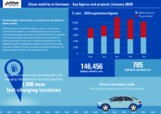Personal transport must keep up with the necessary changes: Citizens are acquiring the latest cars with the new drive systems – in good time and in sufficient numbers – and the government is providing subsidies to ensure that they can also refuel and recharge them. Cities and municipalities are also increasingly updating their fleets, and are being supported both financially and with know-how. After all, climate change won’t wait.
To achieve the climate targets set, Germany needs 10 million zero-emission vehicles on its roads by 2030. The first necessary prerequisites for the refuelling and charging infrastructure will be in place by 2020. With the 100 hydrogen filling stations then in place and at least 36,000 standard and 7,000 fast charging points publicly accessible, mobility with alternative fuels and drive systems will be possible for a large number of people across the country. Not least thanks to the support provided by the corresponding programmes of the German government, a new record has recently been reached in the number of new registrations of electric passenger cars.
With its local electric mobility (“Elektromobilität vor Ort”) funding programme, the Federal Ministry of Transport and Digital Infrastructure (BMVI) supports cooperation between industry, science and the public sector in order to promote the further market ramp-up and the embedding of electric mobility in everyday life. In addition, BMVI and the Federal Ministry for Economic Affairs and Energy (BMWi) are investing in emission-free mobility with hydrogen and fuel cells in the National Innovation Programme Hydrogen and Fuel Cell Technology (NIP2).






